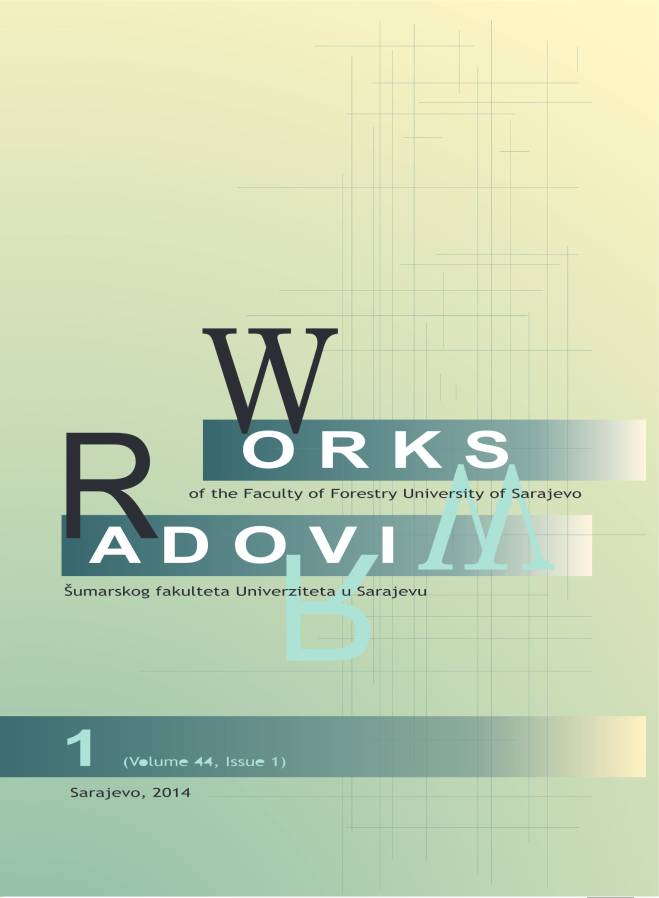ECOLOGICAL STATUS OF RIVER DRINJAČA
DOI:
https://doi.org/10.54652/rsf.2014.v44.i1.106Abstract
UDK: 574.587(282.249 Drinjača)”2012”
More and more intensive unplanned use of water resources in Europe and beyond, have turned the efforts for stopping exploitation and reduction of available freshwater ecosystems. According to the provisions of the Water Framework Directive (WFD), biotic parameters, especially the benthos organisms (zoological component) gives the greatest significance in the appropriate way of identifying the ecological status and typology. This paper presents the application of different biotic indices in assessing the ecological status of the river Drinjača. The analysis reveals a high diversity in the composition of phytobenthos and macrozoobenthos with domination of preimaginal stage of aquatic insects. Acoording to the indices applied, water of the river Drinjača at locations upstream and downstream of the confluence of Jadar is oligo to betamesosaprobic. A high ecological status has been determined by applying biotic indices on the macrozoobenthos composition ehich takes this part of the stream as referent to all other waterstreams of the same type on the territory of Bosnia and Herzeogovina.
Downloads
References
ALBA-TERCEDOR, J. AND SÁNCHEZ-ORTEGA, A. (1988): Um método rápido y simple para evaluarla calidad biológica de lãs águas corrientes basado em El de Hellawell (1978). Limnética, 4: 51-56.
ALBA-TERCEDOR J. (1996): Macroinvertebrados acuaticos e calidad de las aguas de los rios, in IV Simposio del Agua en Andalucía (SIAGA '96), vol. 2, pp. 203–213, Almeria, Spain.
ARMITAGE, P. D., MOSS, D., WRIGHT, J. F., AND FURSE M. T. (1983): The performance of a new biological water quality score system based on macroinvertebrates over a wide range of unpolluted running-water sites, Water Research, vol. 17, no. 3, pp. 333–347.
ARTEMIADOU, V. AND LAZARIDOU, M. (2005): Evaluation score and interpretation index for the ecological quality of running waters in Central and Northern Hellas. Environ Monit Assess. 110,1-3: 1-40.
BARBOUR, M. T., GERRITSEN, B., SNYDER, D., STRIBLING, J. B. (1999): Rapid Bioassessment Protocols for Use in Wedable Streams and Rivers. Peryphiton, Nenthic Macroinvertebrates, and Fish. Second edition. EPA 841-B-99-002. U.S. Environmental Protection Agency, Office of Water, Washington, D.C.
FRIEDRICH, G., CHAPMANN, D., AND BEIM, A. (1996): The Use of Biological Material in Water Quality Assessments: A Guide to the Use of Biota, Sediments and Water in Environmental.
Monitoring, 2nd ed. Deborah Chapman (ed.). E & FN Spon, New York.
HYNES , K.E. (1998): Benthic Macroinvertebrate Diversity and Biotic Indices for Monitoring of 5.
Urban and Urbanizing Lakes within the Halifax Regional Municipality (HRM), Nova
Scotia, Canada. Soil & Water Conservation Society of Metro Halifax. xiv, 114p.
KAZANCI, N. , TÜRKMEN, G., EKINGEN, P., AND BAŞÖREN, Ö. (2013): Preparation of a biotic index (Yeşilırmak-BMWP) for waterquality monitoring of Yeşilırmak River (Turkey)by using benthic macroinvertebrates. Review of Hydrobiology 6,1: 1-29
MCKIW, G.L. (2001): Applied Aquatic Ecosystem Concepts. Kendall/Hunt Publishing
Company. ISBN: 0-7872-7490-9. xxvi, 744pp.
MANDAVILLE, S.M. (2002):Benthic Macroinvertebrates in Freshwaters-Taxa Tolerance Values, Metrics, and Protocols. Research Scientist III, Division of WaterNew York State Department of Environmental Conservation. 168 pp.
UHRECK, C.B. & GOUVERIA, F.B.P. (2014): Biological Monitoring Using Macroinvertebrates as Bioindicators of Water Quality of Maroaga Stream in the Maroaga Cave System, Presidente Figueiredo, Amazon, BrazilInternational Journal of Ecology.
ZUBČEVIĆ, O. (1974): Fizičko-geografske karakteristike sliva Drine. Ribarska osnova Drina I. Biološki institut Univerziteta u Sarajevu str.3-8.























